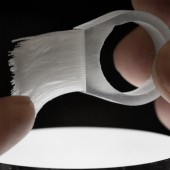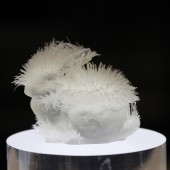Cilllia 3D printing hair by Jifei Ou - MIT Media Lab |
Home > Winners > #50708 |
 |
|
||||
| DESIGN DETAILS | |||||
| DESIGN NAME: Cilllia PRIMARY FUNCTION: 3D printing hair INSPIRATION: Throughout nature, hair-like structures can be found on animals and plants at many different scales. Beyond ornamentation, warmth and a sense of touch, hair is also a natural responsive material that interfaces between the living organism and its environment by creating functionalities like adhesion, locomotion, and sensing. Inspired by how hair achieves those properties with its unique high aspect ratio structure, we are exploring ways of digitally designing and fabricating hair structures. UNIQUE PROPERTIES / PROJECT DESCRIPTION: This work presents a computational method of 3D printing hair structures. It allows us to design and generate hair geometry at 50 micrometer resolution and assign various functionalities to the hair. The ability to fabricate customized hair structures enables us to create super fine surface texture; mechanical adhesion property; new passive actuators and touch sensors on a 3D printed artifact. We present applications to show how the method can be used for designing everyday interactive objects. OPERATION / FLOW / INTERACTION: Using conventional computer aided design software would mean drawing thousands of individual hairs on a computer, translating each hairs contours into a mesh of tiny triangles, a process that would take hours. Cilllia bypassed all that with a new voxel based printing software platform that lets users define the angle, thickness, density, and height of thousands of hairs in just a few minutes. The printed hair can be used as an adhesive surface like Velcro; an actuated surface to move object in designed paths; or a sensing surface to sense user's touch and swipe. PROJECT DURATION AND LOCATION: The project started in February 2015 in Boston and finished in May 2016 in Boston, and will be exhibited in Centre Pompidou in March 2017. |
PRODUCTION / REALIZATION TECHNOLOGY: all samples were fabricated with stereolithography 3D printing. We developed a voxel-based model generation method to instruct the printer to print various hair geometry and structure. SPECIFICATIONS / TECHNICAL PROPERTIES: each sample is approximately 40 by 60 by 60 mm. they can be assembled together to form larger design TAGS: 3D Printing, New Material, Surface Texture, Actuated Interfaces; Acoustic Sensing; Digital Fabrication; Hair. RESEARCH ABSTRACT: This work presents a voxel-based method for 3D printing hair-like structures on both flat and curved surfaces. It allows a user to design and fabricate hair geometries at the resolution of 50 microns. We built a software platform to let users quickly define the hair angle, thickness, density, and height. The ability to fabricate customized hair-like structures not only expands the library of printable shapes, but also enables us to design passive actuators and swipe sensors. CHALLENGE: Most of the current commercially available 3D printers use a layer by layer method to deposit materials into shapes that are designed in the CAD. The process follows a top-down pipeline, in which users create digital 3D models, and then a program slices the models into layers for the printer to print. It is difficult and impractical to create many thousands of small hairs with real geometry using conventional CAD systems. The data for describing the total geometry becomes extremely large and rendering such complex structures can also be computationally expensive. ADDED DATE: 2016-09-26 17:46:43 TEAM MEMBERS (5) : Jifei Ou, Gershon Dublon, Chin-Yi Cheng, Karl Willis and Hiroshi Ishii IMAGE CREDITS: All Photo/video credit to Tangible Media Group, MIT Media Lab |
||||
| Visit the following page to learn more: http://bit.ly/2argzOK | |||||
| AWARD DETAILS | |
 |
Cilllia 3d Printing Hair by Jifei Ou-Mit Media Lab is Winner in 3D Printed Forms and Products Design Category, 2016 - 2017.· Read the interview with designer Jifei Ou - MIT Media Lab for design Cilllia here.· Press Members: Login or Register to request an exclusive interview with Jifei Ou - MIT Media Lab. · Click here to register inorder to view the profile and other works by Jifei Ou - MIT Media Lab. |
| SOCIAL |
| + Add to Likes / Favorites | Send to My Email | Comment | Testimonials | View Press-Release | Press Kit |
Did you like Jifei Ou-Mit Media Lab's 3D Printing Design?
You will most likely enjoy other award winning 3d printing design as well.
Click here to view more Award Winning 3D Printing Design.








